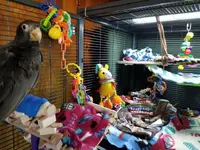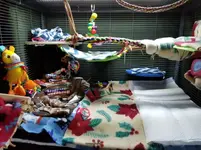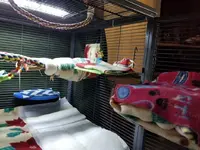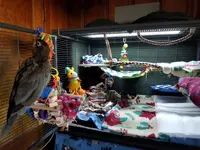I think that a lot of his issue with not moving around much or doing much isn't his disability at all, but rather the fact that he's never done much of anything, and he's scared to death to even try. You mentioned that he is a former breeder-bird, and this type of behavior is extremely common with pretty-much ALL retired breeder-parrots, simply because they have spent most of their lives just sitting inside of a cage. They typically aren't given ANY toys at all, they are never allowed out of their cages at all, not ever (because they are considered to not be "pets" by the breeders, they just want them to breed and that's it, so no toys, no foraging activities, nothing, their entire lives are just sitting inside of a cage not moving, eating, drinking, mating, and depending on the species, the males sometimes also help raise the babies. That's it.) So even if he wasn't missing one leg and had a disabled remaining leg, my guess is that he would be no different at all in his behavior or his fear. It's very much the same as breeders who do not put their babies into a "Weaning-Cage" or a "Starter-Cage" while they are weaning/fledging. If a bird breeder simply move their baby birds after they grow-in their outer feathers from the brooder, which usually has no toys or activities in it, to a basically empty cage with only a food dish, a water dish, and a perch, then the babies don't have any concept of what a "toy" is, or even what "playing" is. All they know is how to sit inside of a cage and preen themselves or their mate, and occasionally eat and drink. That's it. So a lot of this is going to be about you literally showing him how to play with toys, and how to take-part in foraging activities, puzzles, etc. Vasa's are very intelligent parrots, so they need to be mentally-stimulated to be happy, and as soon a you show him how to play with toys and how to forage, he's going to catch-on very quickly.
****Question for you: How does he normally perch/stand? I'm assuming that he's able to at least use his remaining foot/leg to perch and stand on, and to climb along with his beak, correct? If he's able to perch on the remaining leg, then I would start out by buying him a swing to put inside of his cage, if he doesn't already have one. One of those nice, big, wooden ones that Petco sells would be great for a Vasa. Put it inside of his cage, hanging from the top, and then you'll have to SHOW HIM how it works. Put him on the swing just like you would a perch, and then push the swing just like you would for a child. This is something that he can learn in one training-session and that will bring him a lot of enjoyment and get him moving, and it will also get him started on not being afraid of everything new...And then he'll be on his way for you to start showing him how to play with other toys and foraging activities.
It's going to be very important to no overwhelm him with a bunch of new toys or activities at one time. This is why I suggest that you start-out with showing him how to swing first, as it's simple, it's fun, it will get him moving, it's not too scary or overwhelming, and it will be step #1. As far as the first toy or toys you buy for him, this is going to depend on what his abilities to stand, climb, etc. are. The simplest type of bird toy to start-off with would be something that is meant for him to chew-on and shred/rip-apart, like a toy that is made of thick, heavy paper/cardboard that is braided for strength, that has a loop or a clip that will allow you to hang it right in front of the place/perch where he spends most of his time, either from the cage bars at the end of the perch, or from a perch above where he sits...Probably best to hand it from the cage bars at the end of the perch where he sits the most, as that will make it easy for him, he won't have to climb to chew on it/shred it. And with a "shredding/chewing" toy, you won't typically have to show him much, as they usually just start chewing on it. And once he's good with the "shredding/chewing" toy, then get him a wooden block toy that he can chew on. And so on, and so forth. Baby steps, adding only one toy at a time, starting out with a simple swing, then a shredding/chewing toy, then a wooden block toy to chew, then maybe a climbing toy, then maybe a wooden puzzle toys where he has to pick up blocks and put them into holes (since at this point he'll already be okay with wooden-block toys!), etc. Build-up to each new toy or activity (The Dollar Tree has these awesome little wooden puzzle toys where you have to put different shaped blocks into the correct holes, my Senegal loves them, and it's something you can either put in the bottom of his cage or better something that you can play with him out on the floor, after he's already become used to wooden blocks)...
This will be a marathon, not a sprint, because it's going ot take time for him to get used to just being in close-proximity to these new things, let alone actually learning how to play with them. But it will happen as long as you take it slow, don't overwhelm him, start with easy, almost "innate" activities like chewing and shredding, and then build-up to larger, more complex toys and activities. As far as "exercise" goes, obviously trying to teach him how to fly properly is your best bet, as he's not going to be walking around much. The reason he gets so out of breath is because his lungs and his muscles are not used to the exercise and the amount of work that flying requires...Essentially, he's "out of shape", just like we get. So making a safe place for him to practice flying inside of your home is a great idea, get him to fly is short-spurts at first, maybe just starting out with "Recall Training", where he perches on a T-Stand or similar and you stand across the room from him, and you teach him to simply fly directly to you, and he gets his favorite treat and much verbal praise every time he does it. Getting him to be able to fly simply back and forth across the room to you will build-up his muscles, help him learn coordination, help him learn how to safely land on his one foot, and once he starts doing this on a daily basis he will gradually get in-shape, learn how to control his direction and his landings, and this will teach him how to be able to fly around a room without crashing into anything, fly around the house, etc. Again, baby steps that build-on to one another...




